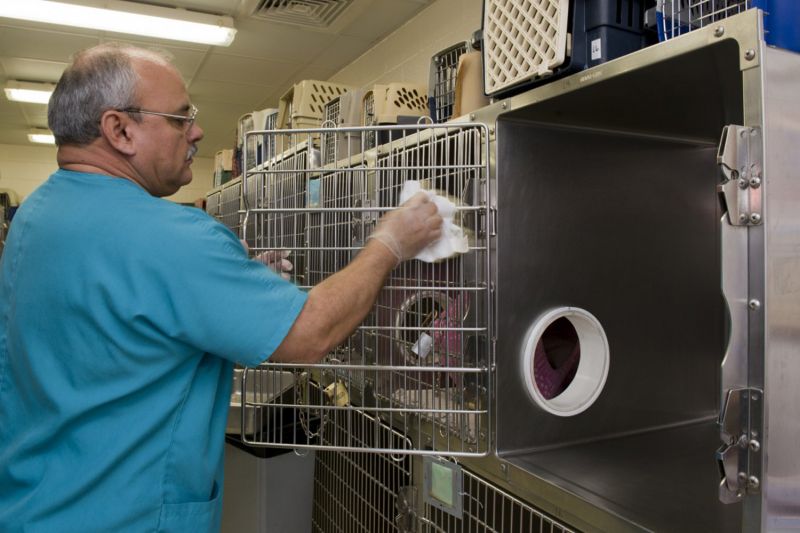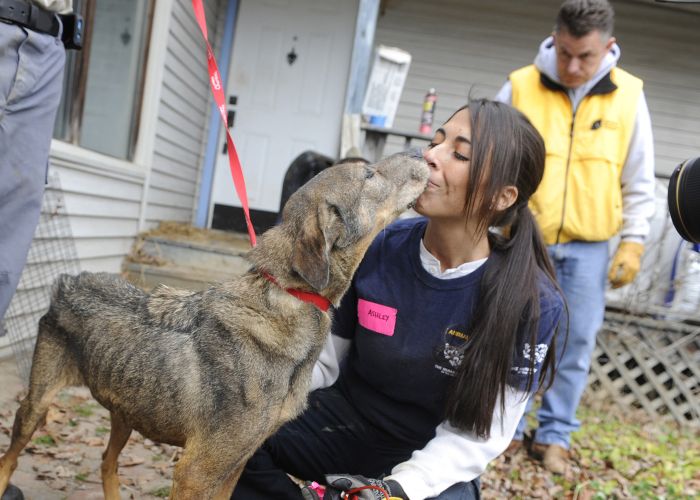Sanitation sanity
Answering your cleaning and disinfection questions

Recently, while teaching an online class covering infectious disease management in the shelter, I made a mistake: I assumed that the audience of shelter and veterinary professionals would want to know about things beyond cleaning and disinfecting! I quickly found out that, while the subject may seem basic, questions abound about new products, how to eliminate certain diseases, and how to clean effectively in shelter environments. I could not keep up with all the questions that came in!
Recognizing the need for more information on this topic, I’ve used this article to answer some questions I’ve received in my courses, and some that came in through Animal Sheltering’s Facebook followers.
What is the difference between sanitizing, cleaning, disinfecting, and sterilizing?
This is such a good question! You may find that these terms are not used by everyone in exactly the same manner—and in truth, they mean slightly different things.
I consider sanitizing to be the practice of eliminating as many infectious organisms as possible. In most shelters, sanitation is accomplished through cleaning and disinfecting.
Cleaning is a manual process. It involves removing dirt and organic debris. Examples of cleaning include sweeping floors, taking out the garbage, scooping poop, and scrubbing a kennel with soap and water. Although cleaning is a very important step, it does not kill infectious organisms. It just mechanically removes them or lessens their presence.
Disinfecting is using solutions to kill or destroy those pathogens that were not removed in the cleaning process. There are some disinfectants, like the quaternary ammonium class, that are able to act simultaneously as both cleaning agents and disinfectants—but many do not have (or possess only weak) cleaning properties; they may fail to effectively remove dirt and grease. In light of this, moderately to heavily soiled areas (typical shelter cages/kennels) should be precleaned. When a product like bleach is applied to a clean cage and allowed to sit for 10 minutes, this is an example of disinfection at work.
Sterilizing is the process of eliminating all microorganisms from inanimate surfaces. Autoclaving spay/neuter instruments is an example of sterilization.
I would like to hear more about accelerated hydrogen peroxide and how to use it. Is it really as safe for staff/animals as they say? Is it effective?
Accelerated hydrogen peroxide (AHP) is a newer type of globally patented disinfection technology only recently made available in the United States. AHP products can be found under different names such as Peroxigard, Percept, Accel, and AccelTB. The active ingredient in AHP products is hydrogen peroxide, but because they contain a combination of surfactants (surface-active agents, which increase the contact of two materials) and inert ingredients, they are very different from typical 3-percent hydrogen peroxide and are capable of cleaning and killing pathogens. Accelerated hydrogen peroxide disinfectants can be purchased as concentrates, wipes, or ready-to-use solutions.
These products have mainly been used in the human health care arena to date, where they are becoming a standard of care. Shelters may be reluctant to employ them due to expense. However, unlike most disinfectants— which require at least 10 minutes of contact time—AHPs are labeled to sanitize (clean) in just 30 seconds and disinfect (kill pathogens) in only five minutes. Efficacy studies indicate a broader spectrum than quaternary ammonium products, including the ability to kill parvovirus, some activity when organic matter is present, and the product appears to be quite safe for users and for the environment. Accelerated hydrogen peroxide products certainly may begin to gain favor in the shelter arena.
My shelter just heard about Wysiwash. Can you tell me more about this product?
Wysiwash is a patented power-wash delivery system for calcium hypochlorite tablets that is being used in some shelters. Calcium hypochlorite is a derivative of chlorine and is the same chemical used to chlorinate swimming pools. To use Wysiwash, a compressed caplet of calcium hypochlorite is placed into a special hose-end sanitizer that discharges diluted solution when sprayed.
Bru-Clean TbC is another product that I have had some recent questions about. It is also available as a patented cleaning and disinfection system and as a premeasured disinfection tablet for dilution in one gallon of water. It, too, is a chlorine-releasing compound. The active ingredient in this product is sodium dichloroisocyanurate (NADCC), a chemical that is commonly used to disinfect drinking water. The Brulin company has developed several special applicators for this product that can be used with degreasers in addition to Bru-Clean TbC. The applicators allow for a foaming cleaning step, a water rinse, and then a disinfection step to occur. The applicators are available as wall-mounted units, portable rolling units, or quick-connect foamer/sprayer units.
Both Wysiwash and Bru-Clean may be desirable alternatives to bleach in a shelter setting due to their easy application systems. Each also may be less corrosive to surfaces and safer for the environment and staff when handled properly. Although Bru-Clean has some detergent capability, Wysiwash does not, and a precleaning step and adequate contact time of 10 minutes are still suggested when either is used. In several independent, controlled laboratory studies, both Bru-Clean TbC and Wysiwash have performed comparably to household bleach in terms of disinfecting capabilities, showing efficacy against common shelter respiratory viruses, canine parvovirus, and calicivirus when used per manufacturer’s direction. Because each of these products is still not widely used in shelters, there remain some unanswered questions about their efficacy in the field.
What should I clean with to get rid of giardia? What about coccidia?
This question comes my way quite often. Giardia is a pesky little protozoan organism that can be the cause of diarrhea in dogs and cats as well as other species. Animals become infected with giardia by ingesting a cyst that has been passed in the stool of an infected animal. Although these cysts survive well in stool and in moist environments, quaternary ammonium products (like A-33, Roccal, Kennelsol, etc.) effectively kill giardia. Thus most typical shelter cleaning protocols should prevent outbreaks from occurring.
In shelters where giardia is an ongoing problem, proper cleaning and disinfecting can be augmented by additional helpful measures such as ensuring that stool is being promptly picked up and disposed of, bathing and grooming affected animals to prevent them from re-ingesting cysts and becoming re-infected, and eliminating any standing water. Coccidia, unfortunately, is a bit trickier. This organism cannot be killed with routine disinfectants. Steam cleaning with commercial machines is recommended for contaminated environments, but is impractical for most shelters. In shelters where coccidia is a common issue, frequent stool removal and pretreatment of high-risk animals with a drug like Ponazuril may be the best option for decreasing environmental contamination.
I am an animal control officer and would like more information about best practices for cleaning my van.
Thanks so much for asking a question about part of shelter work that is frequently overlooked! If an animal is shedding infectious disease and the van area is not properly sanitized after transport, as animals continue to be brought in, there is tremendous opportunity for infectious disease transmission to occur. Several nasty shelter outbreaks have started exactly this way (see animalsheltering.org/distemperoutbreak for a story about a distemper outbreak that may have begun with transport issues).
Vans are essentially very short-term intake housing for most facilities, and the cages and equipment inside should be a part of routine shelter sanitation schedules, just like any other area of animal housing. Best practices would ensure that in addition to cleaning and disinfecting cages between occupants, a certain amount of time is allotted at the end of each shift/day for thorough stocking and sanitation tasks. A daily written cleaning protocol or check-sheet can also be a great tool. Here is an example of what this might look like:
Vehicle cleaning procedures
- Van supplies should be checked at the beginning and end of each shift.
- Supplies on hand should include:
- Spray bottle of disinfectant
- Disposable gloves
- Hand sanitizer
- Clean laundry
- Dishes, etc.
- Equipment that contacts animals (microchip scanner, snappy snare, rabies pole, leashes) should be disinfected between uses.
- Every kennel and all kennel items should be cleaned and disinfected between occupants.
- All kennels should be cleaned and disinfected daily (even if an animal was not housed during the day), using the standard shelter cage cleaning protocol.
- Dirty food and water bowls should be kept in a closed container/bag and removed daily.
- Soiled bedding should be kept in a closed container/bag and removed daily.
- End-of-day tasks should include:
- Disinfection of the floor
- Wiping down of high-contact and/or soiled surfaces, including the steering wheel, walls, and keyboards.
Why is the rotation of chemicals recommended?
Like so many aspects of shelter medicine, there’s no single solution that will be universally applicable for all situations. It is important to have a thorough understanding of the pros and cons of common shelter choices. You may find that it can be useful to rotate chemicals on a regular basis, or during times of particular disease concerns at the shelter. Some shelters rotate quarterly. Others use one product several days of the week, and a product with a different spectrum of activity on alternating days. While it can seem overwhelming to sort through the vast variety of available chemicals, don’t fret! My advice would be to think practically and ask some key questions.
- What are the infectious diseases that the shelter is challenged by? Canine parvovirus, panleukopenia, calicivirus, and ringworm are four of the more hardy pathogens that shelter disinfection protocols should target.
- What needs cleaning and disinfecting? Are surfaces easy to clean, or will you need a product that will work in the face of organic material that may never be fully removed (i.e. wood, carpet, gravel, grass)?
- How much time and expense can be dedicated to cleaning and disinfecting? Most disinfectants require a 10-minute minimum contact time after application. Some of the newer—although more expensive—products have decreased contact times. It could be worthwhile for some shelters to evaluate whether the cost savings in staff time may be worth the expenditure.
- Is staff compliance and ease of use a major concern? Some chemicals come in simpler application formats than others. This should play into your choice, because no matter how much is spent, or how much thought goes into choosing a chemical, if the staff who use it every day do not do so efficiently and correctly, the effort and expense will not pay off. (A sample weekly rotation schedule: Monday—quaternary; Tuesday— quaternary; Wednesday—bleach and degrease; Thursday—quaternary; Friday—bleach; Saturday—quaternary; Sunday—quaternary.)
Do hand sanitizers really work?
Proper hand hygiene is recognized as the best way to stop the spread of infectious disease. Yet studies show us that in health care facilities, hands are only washed appropriately about 25-50 percent of the time.
Especially in animal shelters, reasons for poor hand hygiene include lack of time and inconvenient facilities. Hand sanitizers certainly seem like a practical solution … but do they really work?
Most infection control experts will tell you that they are very effective. They improve compliance and reduce infectious disease transmission. In one interesting study comparing hand washing to alcohol and to chlorhexidine-alcohol gels for reduction of bacterial loads on the hands of people after they performed physical exams of equines (a dirty job!), the use of the gels was equivalent or superior to hand washing.
However, hand sanitizers do have a few limitations. The sanitizer does not kill ringworm, parvo, or calicivirus. In order to work properly, sanitizers have to be selected and used correctly. Alcohol-based products with concentrations above 60 percent are recommended for best efficacy. Hands should be washed a lot in a shelter—at minimum, before and after handling animals and items in animals’ environments; after gloves are removed; and at the beginning and end of each shift. Alcohol-free products should generally be avoided. In addition to being less reliable against calicivirus, some of these products contain compounds like phenols (Triclosan) that can be harmful at high concentrations.
To use sanitizer properly, apply a quartersize amount to your palm, work the sanitizer into the fingertips of opposite hand, repeat with your opposite hand, and rub briskly until dry without rinsing.
The bottom line? In the shelter, hand washing is critical for infectious disease control. Alcohol-based hand sanitizers should be considered an important adjunct to use of disposable gloves and soap-and-water hand washing.
Sanitation in the animal shelter truly is an area where good practices can save lives. Small pieces of misinformation or glitches in protocols are often the root of serious, widespread, and persistent infectious disease problems.






